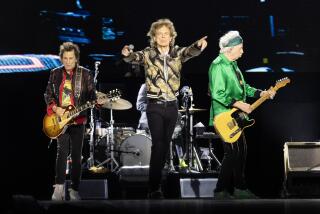CLEVELAND IS ON A (ROCK ‘N’) ROLL
- Share via
CLEVELAND — Driving around in the fog, listening to the car radio here, you’d almost think you’d slipped into the Twilight Zone.
First we tuned into the Indians’ ballgame. Cleveland was ahead, 8-0. We switched to the popular local rock station, which was playing the Fabulous Thunderbirds and Van Halen.
A few minutes later, we scanned the radio dial again. Suddenly, the Indians were behind 10-8. We punched in the same rock station and were treated to a loud blast of Prince and Janet Jackson. Then we turned the dial to . . .
Wait a minute. Janet Jackson and Van Halen, followed by New Order, all on the same station?
Welcome to Cleveland, new home of the Rock & Roll Hall of Fame and home of WMMS-FM, a bona fide hall of fame radio station. Voted the best rock station in the United States in this year’s Rolling Stone readers poll, WMMS calls itself “the last untamed radio station in America.”
It’s no idle boast. Once a hard-core album-rock station, WMMS has, over the past few years, transformed itself into a pop melting pot, playing everything from black artists (Whitney Houston), young guitar-slingers (John Eddie), old rock warriors (Bob Seger) and dance-club favorites (The Art of Noise).
For years, critics have complained that AOR (album-oriented rock) actually stands for “apartheid-oriented rock.” Most rock radio outlets rigidly segregate music, programming a virtually all-white rock format, citing complaints from loyal rock listeners if they do otherwise.
But WMMS has opened up its format to all kinds of sounds--with impressive results. In the latest Arbitron ratings, WMMS landed a phenomenal 13.9 ratings share, making it easily the top-rated station in the market, scoring nearly twice as high as the station’s closest competitor. And that was actually a ratings drop for the station, which had won a 14.5 rating last fall and has been the city’s rock radio leader for nearly a decade. (By comparison, KIIS-FM, L.A.’s top-rated station, had a 7.4 rating in the most recent survey of the crowded L.A. radio market.)
“Why segregate yourself?” said John Gorman, WMMS’ station manager. “We approach rock ‘n’ roll the way it was in the ‘50s. We don’t go for narrowcasting, and I think we’re successful because of our diversity. We feel that the average person on the street enjoys being exposed to a wide variety of music.”
Gorman pointed to a stack of records and tapes by his desk. “We don’t use consultants and we don’t pay attention to a lot of marketing surveys. We don’t want this station to sound like every other station around the country, as if you were going into a McDonald’s. I think all that research underestimates the intelligence of rock listeners. We’re just trying to recapture that spirit from the ‘60s when you could hear the Rolling Stones, James Brown and the McCoys all in the same set.”
Several years ago, sensing the growing staleness of the tradition-bound album-rock format, WMMS officially switched to a Top 40-style sound, though it has continued to play a high percentage of album-rock artists. According to WMMS staffers, the new format is much more in touch with the new generation of radio listeners.
“In most cities today, AOR stations just play catalogue,” said Denny Sanders, WMMS’ evening deejay and, after Kid Leo, the station’s afternoon jock, perhaps the best-known rock deejay in town. “I drove through Toledo the other day and it took me 40 minutes of listening to hear anything recorded in the ‘80s.
“AOR got so stagnant that we couldn’t stand it anymore. It was white bread without the crust. There has to be something more to rock than five white guys with shoulder-length hair playing major-key Chuck Berry tunes in a 4-4 beat with a party-oriented plot line.
“You have to shift with each new generation. In the early ‘70s, every other person was in their 20s. Now much of our audience is in their 30s and we had to address those changes in the marketplace.”
Sanders admits that the station’s initial format switch provoked a howl of protest from longtime WMMS fans. “We definitely got a backlash when we first played Prince,” said Sanders, a 15-year WMMS veteran. “But we also got a backlash in the ‘70s when we first played David Bowie. If we got spooked every time our listeners freaked out over something we aired, we’d still be playing Bill Haley.”
Of course, local rockers still have reservations about WMMS, noting that the station doesn’t devote much airtime to adventuresome bands like the Replacements, R.E.M., Husker Du or the Del-Fuegos. (Fortunately, there are five local college radio stations that give significant exposure to new rock acts.)
“We experimented with playing both R.E.M. and Husker Du, but we didn’t get enough audience reaction,” Sanders said. “No one hated it, but a lot of people called and said, ‘That’s OK, but we want to hear John Cougar Mellencamp. We have gotten a great reaction on the Bangles, so we’re playing them, along with Belinda Carlisle and the Mary Jane Girls.
“But you’ve got to reach the kid at the local Sunoco station. That’s your real audience. It’s simple--you can’t live in the past, because you’ve been there before. And you can’t live in the future, because it’s pure speculation. The way we look at it, rock ‘n’ roll is a wave. Some people are in front of it, some are in back of it. But most listeners are right on the crest, and that’s where we want to be, because that’s where we can have the most influence and impact.”
More to Read
The biggest entertainment stories
Get our big stories about Hollywood, film, television, music, arts, culture and more right in your inbox as soon as they publish.
You may occasionally receive promotional content from the Los Angeles Times.










